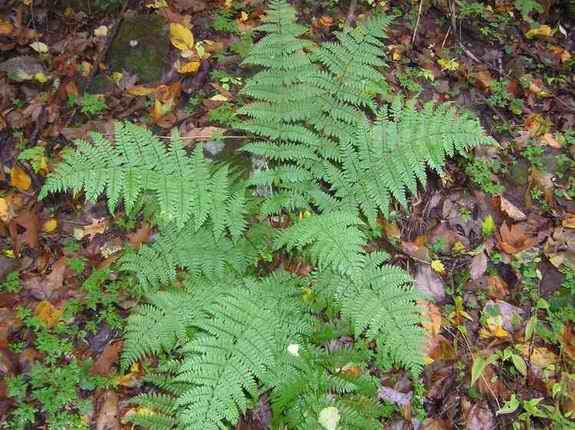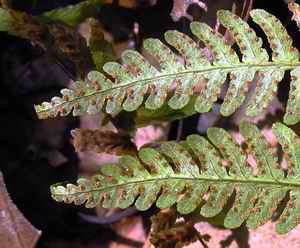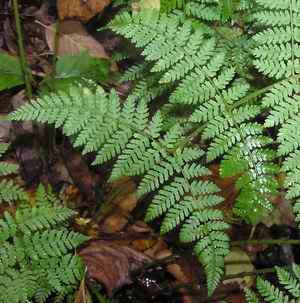|
Return to Hiker's Notebook Home Page
Common Name: Wood Ferns - Named for their preferred woodland habitat Scientific Name: Dryopteris spp - From the Greek drus meaning oak and pteris meaning fern; taken together as "fern of the oak wood."
Wood ferns are among the most "fern-like" of ferns in that the frond has a classic shape with the blade (upper leafy portion) having a taper from top to bottom on an erect stipe (the stalk below the blade). The pinna (first or primary division of the blade) is subdivided into pinnules (second division) that are in some cases further divided into lobes (third division). The "three-cut" leaf configuration is what gives the wood fern a lacy appearance. Wood fern spores are clustered in structures called sori that look like brown dots (they are also called fruit dots) on the leaves. The spores that make up the sorus are dust-like in appearance, discernable only with magnification.
The absence of visible seeds in ferns led to some interesting interpretations as to the nature of fern propagation. As the fern was clearly a plant, it was thought that it must have seeds, a very reasonable conjecture according to Joseph Pitton de Tournefort, a noted French botanist in the late 17th Century. Because the "fern seed" could not be seen, it was claimed by some early herbalists that it must be invisible. This ultimately led to a widely held belief that the invisibility of the fern seed conveyed invisibility to the bearer of the seed, but only if the seeds were collected at midnight on Midsummer Night's Eve, June 23, also known as the eve of Saint John, the shortest night of the year. However, you could only catch the elusive invisible fern seed by stacking up twelve pewter plates beneath a fern leaf, the seed falling through the first eleven plates to be stopped by the twelfth; the absence of the fern seed on the twelfth plate was blamed on roaming fairies. Literary evidence of this belief appears in Shakespeare's King Henry IV. In Act 2, Scene 1, Falstaff is scheming to rob a rich merchant on his way to London. In order to persuade another thief to join him, he proffers "We steal as in a castle, cocksure; we have the receipt of fern-seed, we walk invisible."
The propagation of ferns with spores and not invisible fern seed was not established until 1849, when the noted botanist Wilhelm Hofmeister proffered the first scientific explanation. Spores are either grouped together on the leaves in structures called sori (as in the case of wood ferns) or on a separate structure called a fertile frond (the cinnamon fern for example). Each sorus consists of clusters of spore cases called sporangia that are shielded by a flap structure called an indusium. The asexual spores are released according to environmental conditions to enhance survival. Spores that land in favorable growing areas develop into an intermediate sexual structures called prothallia, which subsequently produce male and female organs known respectively as the sperm producing antherium and the egg bearing archegonium (in most cases on the same prothallium). The preference of ferns for boggy areas is due to the need for a film of moisture so that the sperm can swim to the eggs. The motile sperm is believed to be due to the retention of the processes of their aquatic ancestors. The fern frond grows from the resultant zygote.
The most recognizable of the wood ferns is the marginal wood fern (D. marginalis), which is also known as the leatherleaf wood fern due to the toughness of the leaves. The marginal designation is descriptive and mnemonic, as it refers to the fact that the sori are at the margins of the pinnules (right).
|



 (D.
carthusiana), the mountain wood fern or spreading wood fern (D.
campyloptera), and the evergreen wood fern, intermediate wood fern
or fancy fern (D. intermedia). They are so similar that they
were once considered the same species named D. spinulosa. Spinulose is
the adjective form of spinule, which means small spine, applied here to the
delicate stalk of these ferns. The difference concerns the configuration of
the basal pinna. If the first lower pinnule is opposite and longer than the
second, it is spinulose. If the first lower pinnule is alternate and longer,
it is mountain. If the second lower pinnule is longer than the first, it is
evergreen, as shown (left).
(D.
carthusiana), the mountain wood fern or spreading wood fern (D.
campyloptera), and the evergreen wood fern, intermediate wood fern
or fancy fern (D. intermedia). They are so similar that they
were once considered the same species named D. spinulosa. Spinulose is
the adjective form of spinule, which means small spine, applied here to the
delicate stalk of these ferns. The difference concerns the configuration of
the basal pinna. If the first lower pinnule is opposite and longer than the
second, it is spinulose. If the first lower pinnule is alternate and longer,
it is mountain. If the second lower pinnule is longer than the first, it is
evergreen, as shown (left).